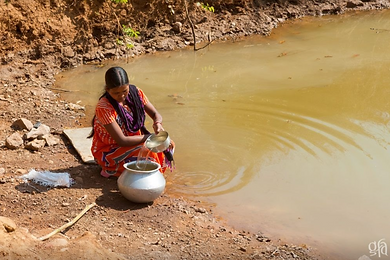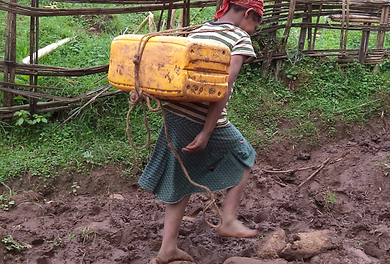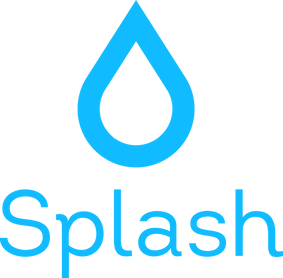
Working Towards
Clean Water
Accessibility
Scroll to continue

Our Grand Challenge
Whenever we are thirsty, we can simply go to the fridge, the nearest water fountain, or the store and get some cold, refreshing water. We see this as a normal living situation while 884 million others around the world see this as a major luxury [1]. These people have to work many hours or walk many miles to obtain often unsafe or semi-clean water. Even in our own country, two million Americans live without basic access to clean drinking water and sanitation [2]. In our research, we choose to focus on two countries that both have major issues with clean water accessibility: India and Ethiopia. Ultimately, this challenge has far-reaching effects on human health and prosperity for everyone around the world.

Causes of the Water Crisis
The story of life is the story of water. Without water, there would be no life on Earth as we know it and no human society. Water is essential, not just for basic life support but also for agriculture, industry, and recreation. Despite the critical importance of water to every living organism, one in four people do not have access to clean drinking water [2].
The causes of clean water scarcity are complex and varied. In most affected regions, a combination of poor climate conditions, poverty, and political issues has led to this challenge.
Click “Learn More” to find out more about these causes.

Effects of the Water Crisis
The lack of access to a clean water source has far reaching effects on human health, poverty, and inequality. Each year, around 1.2 million people die each year from unsafe water sources [2]. The water crisis also disproportionately affects women and children, who are largely responsible for walking long distances to gather water. Additionally, the water crisis and poverty are inextricably linked in a self-reinforcing feedback loop.
Click “Learn More” to find out more about the consequences of poor water accessibility.

Empathetic Experience
How many miles can you walk in a day? What about carrying 50 pounds of water? Our exhibit explores having to walk long distances with heavy loads for this basic human necessity and provides insight into life in areas without easy access to clean drinking water.
The first part of the exhibit is the photo tunnel. Walk through the tunnel and keep in mind that every step you take in the tunnel is equivalent to 1,480 steps outside.
The second part of the exhibit is the buckets of 'water.' To avoid potential spilling, the water has been replaced with rocks of a similar weight. Pick up each bucket to feel the approximation of the weight they have to carry. Now imagine carrying it 3.7 miles.
The final part of our empathetic experience is the H2 Uh Oh! game. The game represents the urgency and necessity of finding water in our focus areas. The game puts the player in the shoes of a water collector and shows the difficulty of collecting water.

Past Attempts
Although a lot of progress has been made to improve clean water accessibility, a lot of work remains to be done. In 2018, the UN launched the Water Action Decade and outlined a series of goals pertaining to clean water accessibility, water pollution, and water management [4]. Work by the UN and other organizations has been able to accomplish a lot, but there are still problems with these implementations. In this section, we present our research on past efforts to solve this grand challenge. We will explore the ways the efforts worked and how we could apply those ideas. It will also show the ways the efforts did not work and how we could avoid those issues.
Click "Learn more" to find out more about these attempts.

Leadership Showcase
There are thousands of charitable organizations and leaders working on the water crisis today. In this section, we present some of these impactful leaders who have made a difference in this challenge and discuss what makes them such effective leaders. The people that we learn more about in our Leadership Showcase are:
-
Eric Stowe: Founder of Splash
-
Georgie Badiel: Georgie Badiel Foundation
Click "Learn More" to find out more about these amazing leaders.

Links to Donate
Splash
-
Develops filtration systems for poor urban areas that lack access to clean water. Splash focuses on schools and orphanages in 8+ countries.
Georgie Badiel Foundation
-
Builds and maintains safe water wells in Burkina Faso and provides technical training to maintain water pumps and educational programs for sanitation and hygiene.
Blood: Water
-
Provides technical, financial, and organizational support so that African civil society organizations expand the reach and effectiveness in the communities they serve.
Water.org
-
Ensures everyone has access to safe water and sanitation by removing barriers and advocating for system change and provides micro financing in new ways to bring small easily repayable loans to those who need access to financing resources to make household water and sanitation solutions a reality.
H20 For Life
-
Provides service learning opportunities for schools in the US that helps teachers and students raise awareness about the global water crisis and takes action to provide funds for water, sanitation, and hygiene education projects for schools in the developing world.
Drop in the Bucket
-
Build wells and sanitation systems at schools through sub-Saharan Africa, to enable youth to fully harness the life changing power of education. Building wells at schools to empower children (specifically girls) to go to school instead of fetching water for hours.